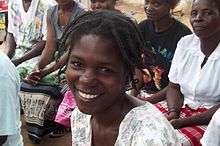Women in Angola
 Angolan woman participating in an adult literacy program | |
| Global Gender Gap Index[1] | |
|---|---|
| Value | 0.6659 (2013) |
| Rank | 92nd out of 144 |
Almost no research existed on the role of women in Angolan society in the late 1980s, there are a few generalities that could be drawn. In rural Angola, as in many African economies, most of the population engaged in agricultural activities. Women performed much of the agricultural labor. Marriage generally involved family, political, and economic interests as well as personal considerations. The household was the most important unit of production and was usually composed of several generations. The women grew and prepared most of the food for the household and performed all other domestic work. Because of their major role in food production, women shared relatively equal status with men, who spent much of their time hunting or tending cattle.
Many women belonged to the Organization of Angolan Women (Organização da Mulher Angolana—OMA). Before independence, the OMA was instrumental in mobilizing political support for the MPLA among thousands of Angolan refugees. After independence, and especially after the creation of the MPLA-PT in 1977, the mass organizations came under the strict control of the party and were given the role of intermediaries between the MPLA-PT and the population.
In 1987 the OMA had a membership of 1.3 million women, most of whom lived in rural areas. Among the many contributions of OMA's members were the establishment of literacy programs and service in health and social service organizations. Most OMA members, however, were poor and unemployed. In 1988 only 10 percent of MPLA-PT members were women, although more women were finding jobs in teaching and professions from which they had been excluded in the past.
References
![]() This article incorporates public domain material from the Library of Congress Country Studies website http://lcweb2.loc.gov/frd/cs/. (Data as of 1989.)
This article incorporates public domain material from the Library of Congress Country Studies website http://lcweb2.loc.gov/frd/cs/. (Data as of 1989.)
- ↑ "The Global Gender Gap Report 2013" (PDF). World Economic Forum. pp. 12–13.
